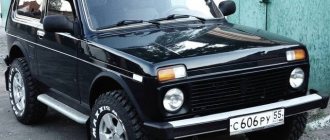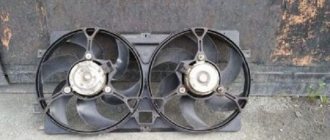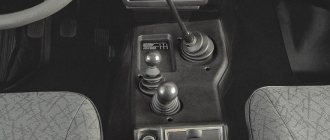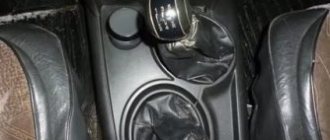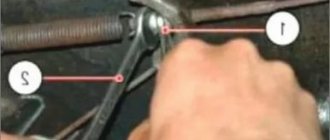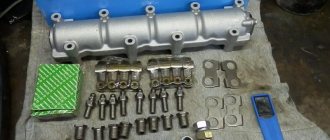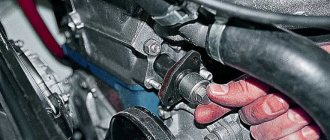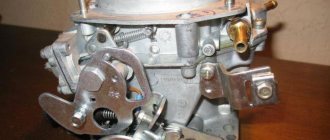- December 10, 2019
- Cars
- Vladimir Skvortsov
The favorite car of fishermen and hunters is the Niva. And the reason for this attitude is the opportunity with its help to get to remote and rarely visited places. What allows you to achieve such results? There is a lock on the Niva. How it helps and in what ways will be discussed below.
About the transmission
First of all, a few words about the structure of the Niva. It has permanent all-wheel drive. What does it mean? It's simple - torque is simultaneously transmitted to four wheels. This is one of the fundamental differences between the Niva and other cars. They supply torque to only one of the axles (front or rear).
All-wheel drive is implemented through the use of a transfer case. The torque, having passed through the gearbox, goes to the transfer case, and from it to the front and rear axles. This design makes it possible to create a locking center differential on the Niva, which, together with all-wheel drive, provides it with increased cross-country ability. Here it is necessary to say a few words about the differential. Largely thanks to him, the excellent off-road characteristics of the Niva are realized.
Chevrolet Niva
Nothing is in doubt, except, perhaps, acceleration on ice. Science says that locking should slightly improve acceleration, but in reality it turned out differently. The problem is that it is much easier to keep two wheels on the verge of slipping than four - at the same time, they slip more sharply. And even a slight slip on ice leads to a loss of acceleration efficiency.
The results are confirmed by estimates obtained on a lap and a reset - it is obvious that it is better to maneuver with the differential unlocked. But on a straight line, the rigid connection of the bridges slightly stabilizes the behavior of the car. The real help from blocking is on climbs, when the weight distribution changes and the unloaded front end is prone to slipping.
So, locking the center differential on smooth, slippery roads, with the exception of driving uphill, does not provide any advantages, and in corners it even harms, complicating controllability.
Understanding the differential
This device allows the car to move freely in a given direction. When turning, the left and right wheels of the car travel different paths. And if they are rigidly connected, then one will slip and the other will slow down. In addition, in this case, the load on the axle increases sharply, which will result in its breakdown or excessive wear of the rubber.
The differential allows you to cope with this problem. On conventional cars it is located on the axle between the wheels, allowing them to rotate independently of each other. The differential distributes the torque received by it between the wheels, and not in equal proportions, but depending on the driving conditions of each - one more, one less.
The same applies to axles in general (front and rear). Their movement, for example when turning, also differs. To distribute forces, a so-called center differential is used. Thanks to it, depending on driving conditions, the torque transmitted to the front and rear axles will differ.
Niva drive device
The chassis of the car is made on the principle of permanent all-wheel drive - torque from the power unit is transmitted to all 4 wheels. This scheme improves the performance of the car when driving in off-road conditions, while simultaneously reducing the load on transmission parts.
The Chevrolet Niva drive consists of the following components:
- Gearbox.
- Transfer case.
- A pair of drive and cardan shafts.
- Front and rear axle gearboxes.
The transfer case is designed to distribute torque between the drive axles of the vehicle. The car is equipped with a two-speed transfer case, which provides:
- stable running of the machine when driving at low speed and at high engine speeds;
- power distribution between drive axles, depending on road grip.
The differential is one of the most important elements of the transmission. Its main purpose is to distribute traction force, and, if necessary, ensure rotation of two consumers at different angular speeds. The Chevrolet Niva drive transmission has three differentials:
- One for each axle (inter-wheel) - they allow the wheels of the same axle to rotate at different speeds.
- The third (interaxle action) - transmits power from the power unit to both axles of the vehicle. It also allows the shafts to operate at different angular speeds, depending on operating conditions, which significantly improves controllability.
A pair of cardan shafts (CV joint or cross design) provide connection between the transfer case and the drive axle gearboxes. Both car shafts have the same design - they are interchangeable.
The front and rear axles transmit force from the transfer case to the drive wheels through external and internal angular velocity joints.
Features of differential operation
The moment is distributed in such a way that it is transferred to where the load is less. This can be confirmed by the usual picture - the car has three wheels on the asphalt, and one on the ice. She fails to move. The friction force of rubber on ice is much less than that of rubber on asphalt, which means that the load on a wheel standing on ice is less than on others.
And the differential transmits all the torque towards the minimum load. As a result, one wheel rotates at breakneck speed, while the rest stand still and the car does not move. The situation is approximately the same when a car cannot climb a mountain on an icy road. In this case, one wheel caught on ice spins, but the car stops.
Work that no one needs is being done. The wheel “grinds” the road surface (ice). Getting rid of such useless work is blocking both on the Niva and on any other car adapted to difficult roads. But usually the devices described are not available on all machines.
How to use the cross-axle differential device lock
Before you start using the cross-axle differential locking mechanism, you need to find where the corresponding shift lever is located on the Chevrolet Niva. In the car interior of this SUV, between the front seats - driver and passenger, there are two levers with handles of different lengths:
- the first is for changing gears (it has a longer handle);
- the second is for controlling the transfer gearbox (it has a shorter handle).
Now let's look at the entire process of controlling the blocking process of the cross-wheel differential device.
- As soon as the vehicle enters the off-road lane, it should be stopped.
- Turn on the differential locking process using a lever with a short handle - move it to the left side (if everything is done correctly, the corresponding lamp indicator will light up on the dashboard).
- Drive off-road with the differential lock engaged.
- As soon as the vehicle drives onto a flat road, the lock should be turned off - move the lever with the short handle to the right.
- You can continue moving.
All the described actions for turning on the differential device blocking are effective when the weight is unevenly distributed between the wheels of one axle.
Disabling the differential locking process on a Chevrolet Niva is necessary when driving on a good road. Otherwise, excessive loads on the vehicle transmission will lead to increased fuel consumption and rapid wear of the tires on the wheels.
Experts pay attention to the following nuance: blocking the inter-wheel differential device will not increase the adhesion force of the wheels to the road surface.
What are the types of blocking?
Usually there are two types - inter-wheel and inter-axle. The first ones block the operation of the differential installed between the wheels on one axis. The purpose of the interaxle blocking is to ensure the distribution of forces between the axles.
The Niva has three differentials, a center differential and two cross-axle differentials. But they are fundamentally different. If the inter-axle differentials are free, there are no additional devices on them, then the inter-axle differential has a forced lock. It greatly facilitates the movement of the vehicle in off-road conditions, partially giving it the capabilities of an all-terrain vehicle.
Comparison of differential locks on Lada 4×4 (VAZ 2121)
The first video review compares the cross-country ability of SUVs in deep snow. The following participants took part in the test: Lada 4×4 with DAK, with DAN and without differential lock. To ensure the accuracy of the tests, all three cars had the same wheels with Bear tires.
Based on the results of the races, you can notice an obvious difference between the competitors:
- Lada 4×4 with DAK coped with the task.
- Lada 4×4 without a self-locking brake was not only unable to drive through deep snow, but also stalled, trying to overcome the snowdrifts along the previously left track.
- Lada 4×4 with DAN passed the test best of all.
Another comparison of self-locking differentials was carried out by another group of VAZ 2121 car enthusiasts. This time the tests took place in the summer, on sand and mud.
SUVs with different “blockages” tried to climb the mountain, as a result:
- With DAK - I managed to climb the slope on the 3rd attempt.
- WITH DAN - I managed to climb the hill only on the 5th try.
Despite this, the expedition participants noticed that on the way to the test site, the Lada 4×4 with DAN confidently drove under its own power, unlike many other SUVs.
During the break, they said that much still depends on the manufacturer and the gap in the design of the device. The minimum gap allows you to work more accurately; torque is transferred to the second wheel after a slight shift of the first. It also plays an important role which lock will be installed on the front wheels and which on the rear wheels.
Where can I buy?
Differential locks and other accessories are available at low prices in our online store.
What kind of differential lock do you recommend for the VAZ 2121? Maybe because of the high price (about 10 thousand rubles) there is no point in using it at all? Let us remind you that other important factors also influence the cross-country ability of an SUV.
Keywords: 4x4 front suspension | rear suspension 4x4 | Niva front suspension | Niva rear suspension
+3
Share on social networks:
Found an error? Select it and press Ctrl+Enter..
How does the differential lock work on the Niva, the principle of operation
When driving on a normal road, torque is distributed relatively evenly between all wheels. But off-road, in the mud, this is not enough. A simple situation - the car has skidded, for example the left rear wheel. Then all the torque will go there, and the car will not be able to drive. In such a situation, no all-wheel drive will help.
But there is a way out. You need to turn on the center lock. How does such a device work on Niva? The transfer case has a special clutch. When the lock is activated, it connects the shafts that transmit torque to the axles. Let's just say that the force produced by the engine is forcibly divided equally between them. Thus, the entire moment does not go to the slipping wheel, but part of it goes to the front axle (in our example).
Now the four-wheel drive starts working. When the locking is on, the front axle is forced to receive half the torque produced by the engine. Thanks to this, the car starts to move. As soon as it starts moving, the slipping of the rear wheel will stop, and torque will flow to all the others. Then the Niva will safely overcome the difficult section.
It should be noted that the Lada 4x4 car is not the only owner of the described device. A similar differential lock works both on the Chevrolet Niva and on other SUV models, however, it can be implemented in different ways. But nevertheless it performs similar tasks.
A few words about the Chevrolet Niva transfer case
I think it’s time to talk about the transfer case of the Chevy Niva, because those who just bought this car, at the very beginning of use, do not really know how to use the transfer case, what the rules are, and in general, when to lower the gear and when to lock it. Let's figure it out now. It’s a pity, of course, that I didn’t record a video on today’s drive along a fairly washed-out road. Well, never mind, I’ll record it and show it clearly on video. For now, in words.
In general, the transfer case switches to a lower gear, as well as to lock, and it is possible and even necessary to do this at the same time. It’s convenient on the Shevik - this is done with one lever.
Turn it down - right up. Add lock - Pull the lever all the way to the left. Look at the switch handle, it's written there. Letter designation - L(low) - low, N - neutral, H(high) - high, that is, normal.
How inter-axle locking works - read this article. There you will also learn about self-blocks - a real cool upgrade for the Chevrolet Niva, which will allow you to drive even further.
Well, now we’ll figure out when it’s better to turn it down, and when to also lock it. And how to do it correctly.
It looks something like this - we are driving across the field in normal second/third gear. Suddenly there is a terrible puddle ahead. We stop and turn down the car.
This is the first rule - when you engage the lower gear, you must definitely stop, that’s how the Shevik differential is designed. But the lock can be turned on and off without stopping. But do you need to always enable the blocking? It’s an interesting question and I’ll tell you what - I use it in exceptional cases, when the dirt is not out of the blue, but there are all sorts of potholes and where there is a risk of catching the “diagonal”.
You may ask - how long does it take to turn on the blocking and then turn it off? There is another nuance here - very often, many owners of the Chevrolet Niva have a problem with the blocking - it does not turn off. It just jams and that’s it, you have to drive on the highway with the blockage. This, you understand, is very harmful for the machine and in such cases you must turn it off.
How to turn off the interaxle? There are several options - turn on reverse, accelerate a little and try to dislodge the lock while driving. You need to do this at speed; it works quite often. Moreover, you can accelerate forward and also try to turn off the lock. I also got stuck once, but even then I didn’t notice it right away and it’s not a problem. Therefore, look at the on-board computer - when the lock is turned on, the following combination will “burn”:
In bright sunny weather it is sometimes difficult to see. Be careful. Well, about turning off the center wheel - I managed to turn it off just when reversing. Needless to say, now I turn it on only in the most dire cases. In the rest of the others, lower gears are quite enough for me.
Just today I went to the lake to check if the ice had melted. The road was washed out, the snow had already melted and turned into liquid mud, and it’s not safe to drive through such mud on my AT tires. It feels like it’s being dragged in all directions, but the most important thing is that I’m driving, I don’t get stuck, and sometimes the ruts were almost to the very bottom; when you shuffle, it always becomes unpleasant)) After some short drives, the car looked “military-like” - all covered in mud , went to the city - people look around))
And here’s another observation of mine: it’s better to drive through mud slowly but surely. This applies to lower gears - if the mud is serious, then I always drive in first, pushing hard, trying to feel the wheels spinning in the mud. If you accelerate a little, you can immediately “burrow”, this is the case when there is no hard covering under the liquid mud. This happens when driving through spring fields. That’s why it’s better to do it slowly, at first. Operate the pedal, don’t accelerate, feel how the car is really “rushing” - at first it feels great.
Well, a lot, of course, depends on the tires. Sometimes, if the tires are toothy, it is useful to accelerate so that the tread cleans itself. For Nivka and Shevik I highly recommend Cordiant Offroad tires, and if you have a little more money, then imported ones - Kumho and of course Hankuk Dinapro MT. Imported tires are more comfortable and are better for driving on the highway because they are soft. Well, in terms of cross-country ability, everything is also very cool here - after all, the tires are a Mud Terrain class, which means they are simply designed for mud.
When you turn on the second lower gear, the car accelerates, but if you get into a mud hole, there is a risk that the engine will “choke” (it is very difficult to spin the wheels in the second gear when stuck) and you will stall. Needless to say, stalling in a deep puddle can be dangerous. Therefore, if you decide to overcome a puddle or muddy area with acceleration (very often this makes sense), then be prepared in the middle, if you suddenly start to fall through, immediately switch from 2 to 1 low, so as not to stall.
All this knowledge - when to go in first and when in second, when to turn on the lock and when not necessary - all this comes with experience. You’ll ride in the mud and you’ll already begin to understand that it’s better to take the puddle over there with acceleration without locking, and that clay hill with potholes - only at 1 lower gear and with the locking on. Think with your head first, and don’t rely on the car to pull it out. The Chevrolet Niva is an excellent car, if you don’t be stupid.
I remember when we were making our way to an abandoned village, we got to one really dangerous place, and there was a UAZ standing there and didn’t dare to drive through. We scouted around and decided that we would pass. And we drove by, leisurely, pushing hard, without particularly accelerating.
Therefore, one more rule (which I always adhere to) - if the place is dangerous, there is a risk of getting stuck, then get out of the car, poke it with a branch, find out the depth of the puddle, rut, feel for a solid place where you can drive. This is the job of the navigator, so let your partner get out of the car and don’t be lazy. Spend 5 minutes on reconnaissance so that you don’t have to spend several hours later getting out of an ambush.
When to use blocking
Under normal road conditions, you don’t need to turn on anything on the Niva. But on a country road or before a steep climb, the driver should think about safety nets. We have already found out how blocking works on Niva. So you should resort to its help if obstacles arise while driving, and this must be done in advance, before the car gets stuck.
If there is a difficult section ahead, it is best to turn on the blocking in advance, especially since it does not take much time. You just need to remember that using the lock unnecessarily does not contribute to the safety of the car and leads to excessive consumption of gasoline and tire wear.
How to enable blocking
It's quite easy to do. On the Lada 4x4 car there are three levers to the right of the driver, we are interested in the smallest one. When the driver moves it back, the lock on the Niva 2121 works; as soon as the driver moves the handle forward, the mode will turn off. It is best to carry out all manipulations while the vehicle is stationary.
Experienced drivers know that the lock does not always turn on (off) the first time. The fact is that the shafts may not be in the right position or they may “bite” if additional force is applied to the coupling (for example, the car has stopped while turning). Then you need to drive forward or backward a little, align the wheels and try again. As a rule, in this case everything turns on.
On the Chevrolet Niva, this procedure is performed differently. There are not two levers to control the transfer case modes, but one. The one we need is located closer to the driver. Although the locks on the Niva-Chevrolet, as well as on the Lada 4x4, work in the same way, they are activated differently. On a Chevrolet, to do this, the transfer case mode control lever must be moved with the clutch depressed while the car is stationary to the left (towards you). To disable the blocking, go in the opposite direction.
Enabling the differential lock
On the Chevrolet Niva it is possible to turn on all three differentials at the same time . Thanks to this, the vehicle’s cross-country ability increases several times when driving off-road.
Forced locking means that the drive wheels are combined with each other, as a result of which they can rotate at the same speed. Thanks to the blocking, the traction force of the engine will be used to the maximum and transmitted to the wheels.
As already mentioned, the differential assembly consists of shafts and gears. With their help, the traction force is automatically distributed between the drive wheels. The differential is locked using a blocker (clutch) . In this case, when the driver turns on the forced locking, the wheels “become” connected to each other. This helps ensure that they rotate evenly.
Differential assembly
If the center lock is forcibly engaged, then the front and rear axles are also rigidly connected at once, which guarantees an even distribution of traction to all four wheels. Thus, the vehicle’s cross-country ability will be increased several times , which makes the Chevrolet Niva a real SUV.
Applying a lock
Not all cars are equipped with blockers, and therefore they will be vulnerable off-road. In this regard, Chevrolet is a unique car that can move with either one or all-wheel drive , which allows it to feel confident even on mountain roads.
To engage the differential lock, pull the lever all the way to the left.
Forced blocking should be enabled in the following cases:
- When overcoming difficult sections of the route. In this case, the blocking should be turned on in advance, even before leaving for such an area.
- On steep climbs or slopes when wheel slip is possible.
- When driving on sand.
- When driving on snow or ice.
Disable blocking
When the Niva moves on a regular road with a smooth surface, it will not need to lock all wheels. They will adhere normally to the surface and not slip, since the traction force from the engine will be distributed evenly over them. For this reason, when the car is moving on a good road where the wheels will not slip, the use of a differential will not be required .
The differential lock on the Niva is a faithful assistant to the driver
All-wheel drive does not always provide off-road capability. Often this is not enough. When, as on the Niva, the locking works in conjunction with all-wheel drive, we can say that the car is at least close to all-terrain vehicles. And with such a car it is quite possible, if not to conquer the muddy roads, then to move quite safely along country and abandoned roads.
But do not forget that differential locking is a mode for difficult driving conditions. But there is no need to be afraid of him. We must remember that blocking allows the Niva to drive where others will not even try to do so. But you shouldn’t turn it on unnecessarily in the city. This is fraught with excessive gasoline consumption, tire wear, and ultimately, car breakdown.
Rules for using blocking in the field
To ensure that the locking mechanism lasts for a long time, use the following rules:
- It is necessary to switch the transfer case when the Niva does not move.
- The differential can also be engaged while the vehicle is moving.
- To ensure efficient and long-term operation of the device, it is advisable for the Niva driver to turn on the lock from time to time. Once a week in winter is enough.
Where is the lever responsible for switching located? Pay attention to the area between the wings located in front, there are 2 levers there. One makes it possible to change gears at the gearbox, the other successfully controls the transfer case.
The basis of the transfer case is a gearbox, which includes 2 stages. The control lever comes directly from it, you can move it forward and backward - this is how the gear is changed on the Niva. The direction of movement of the lever to the left and right allows you to activate the differential lock and vice versa to disable it.
